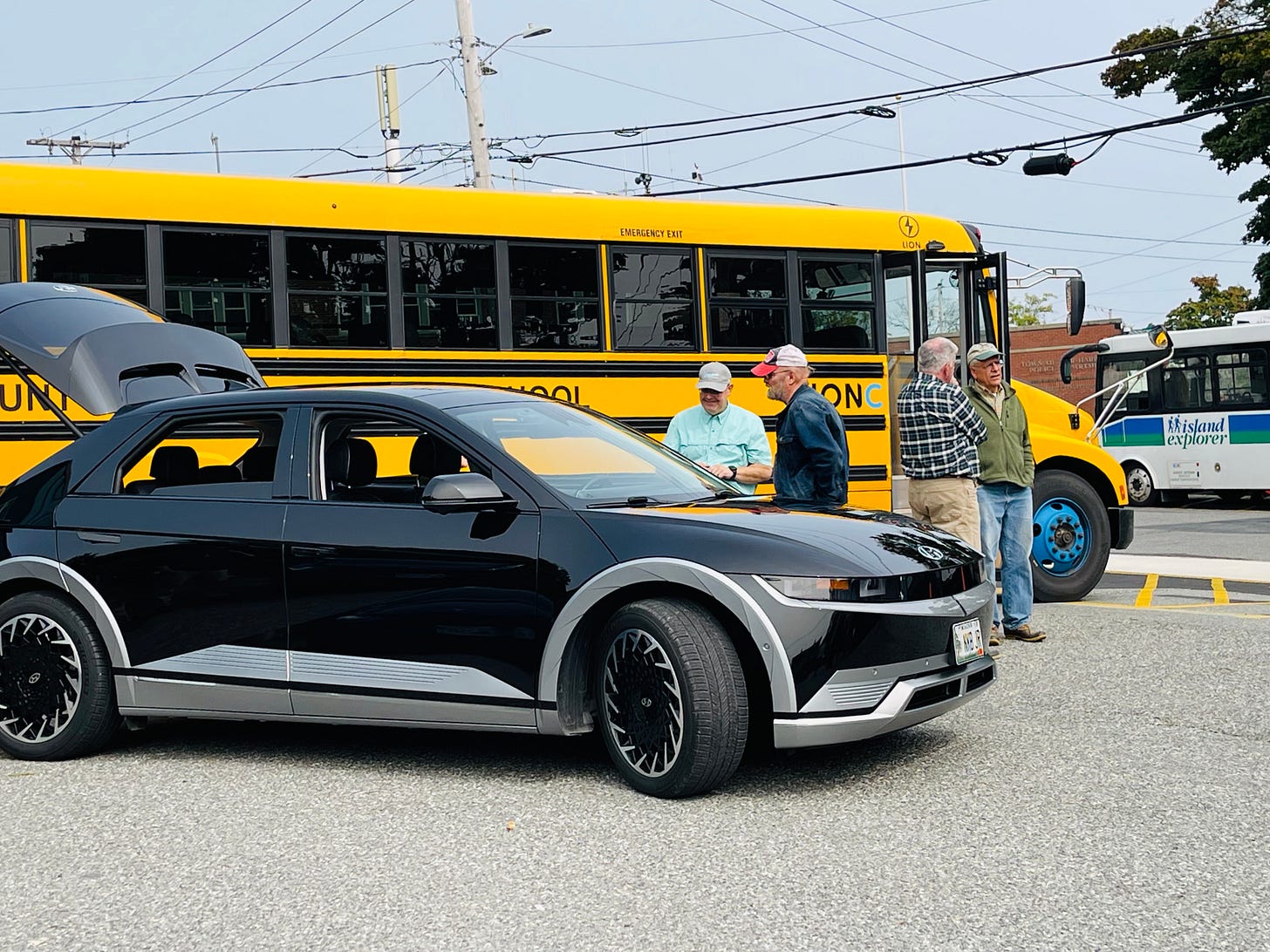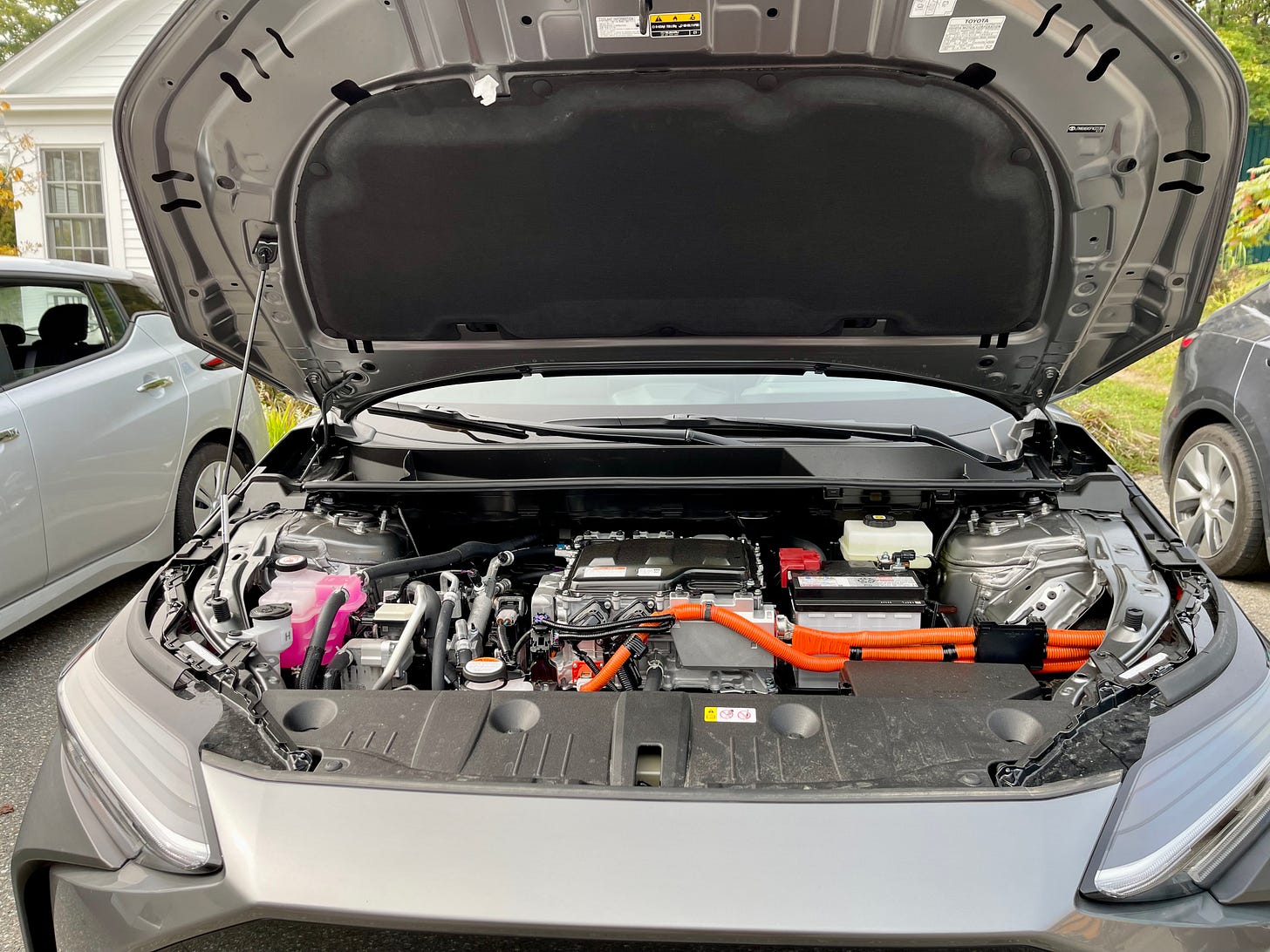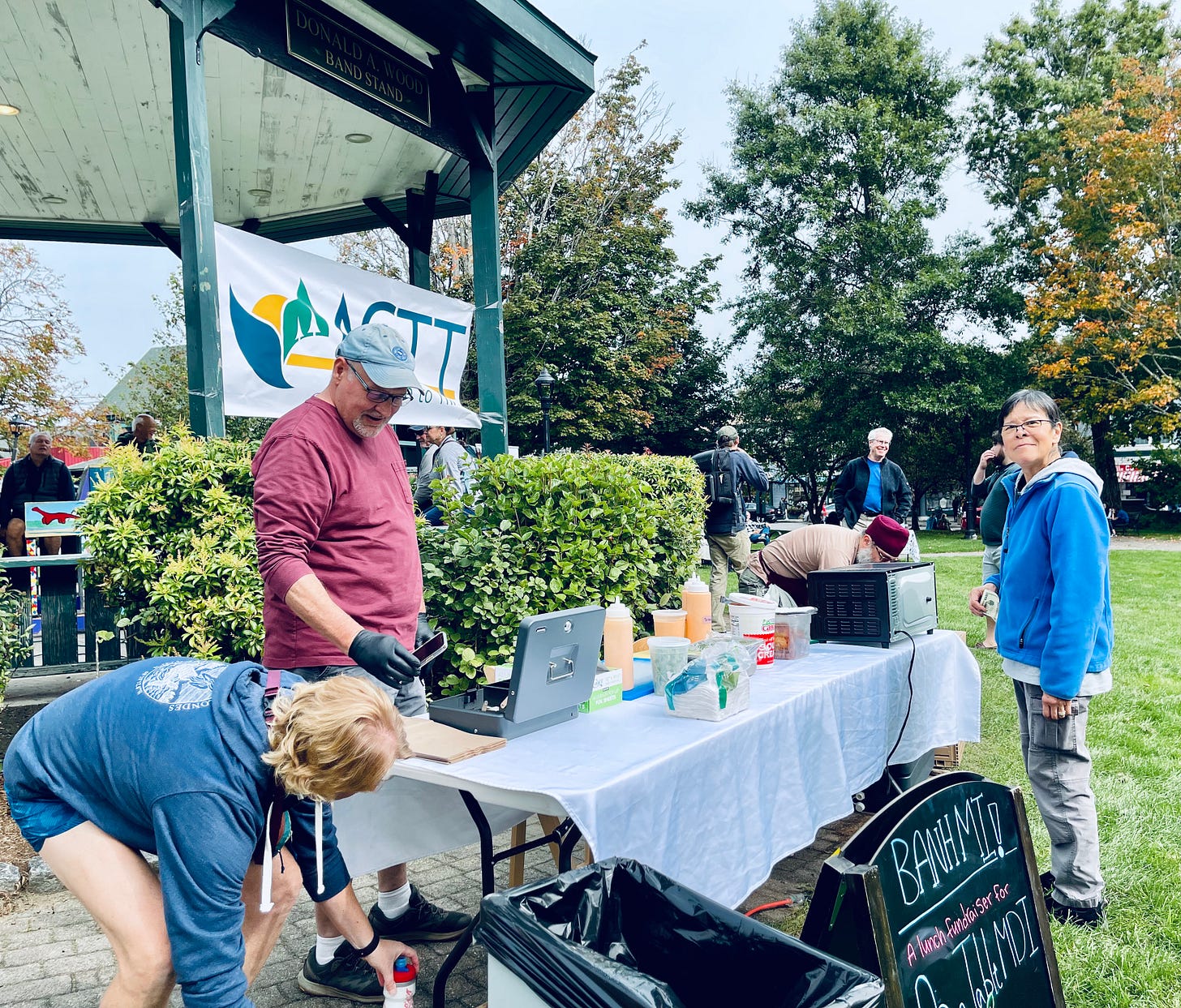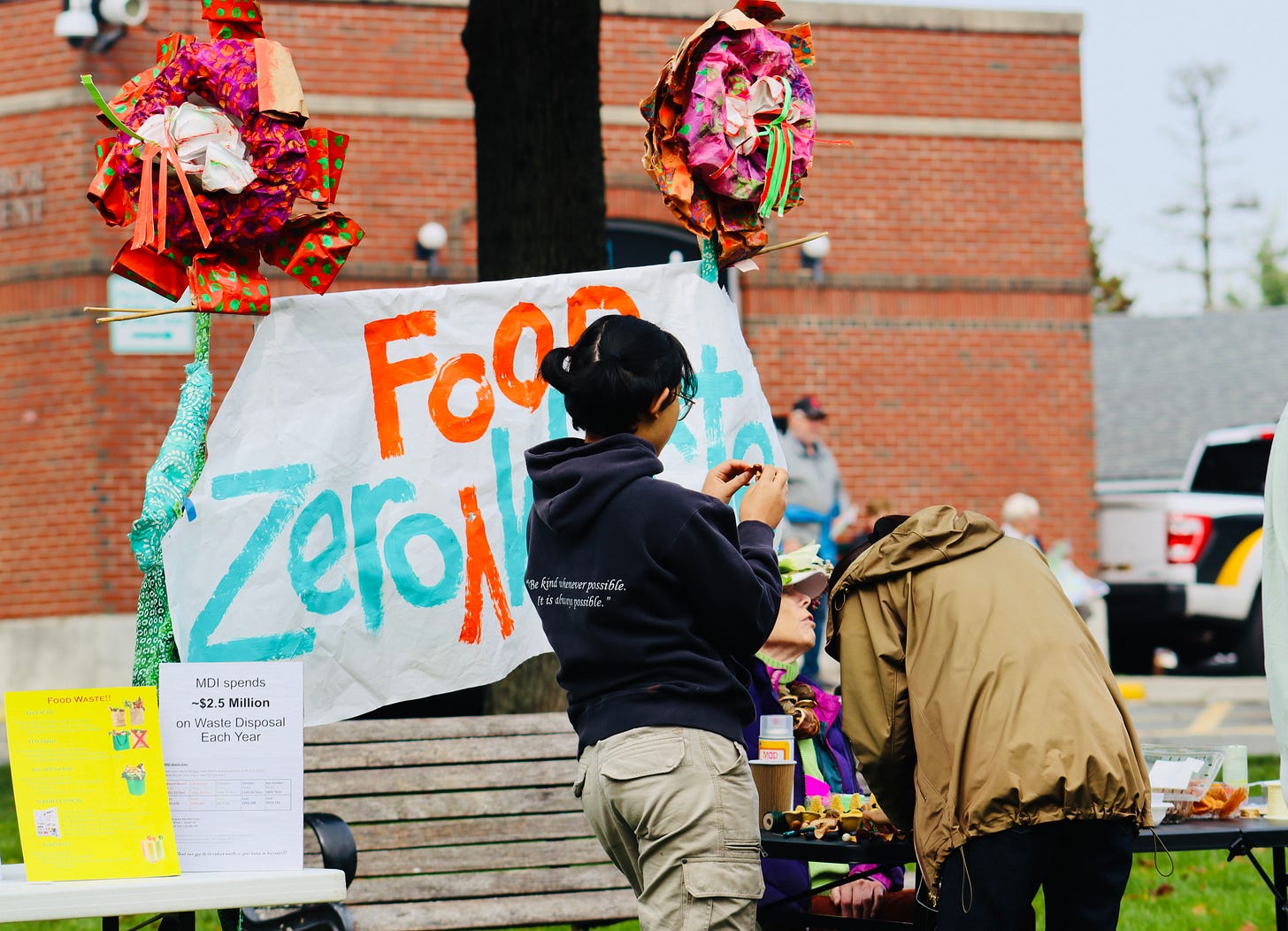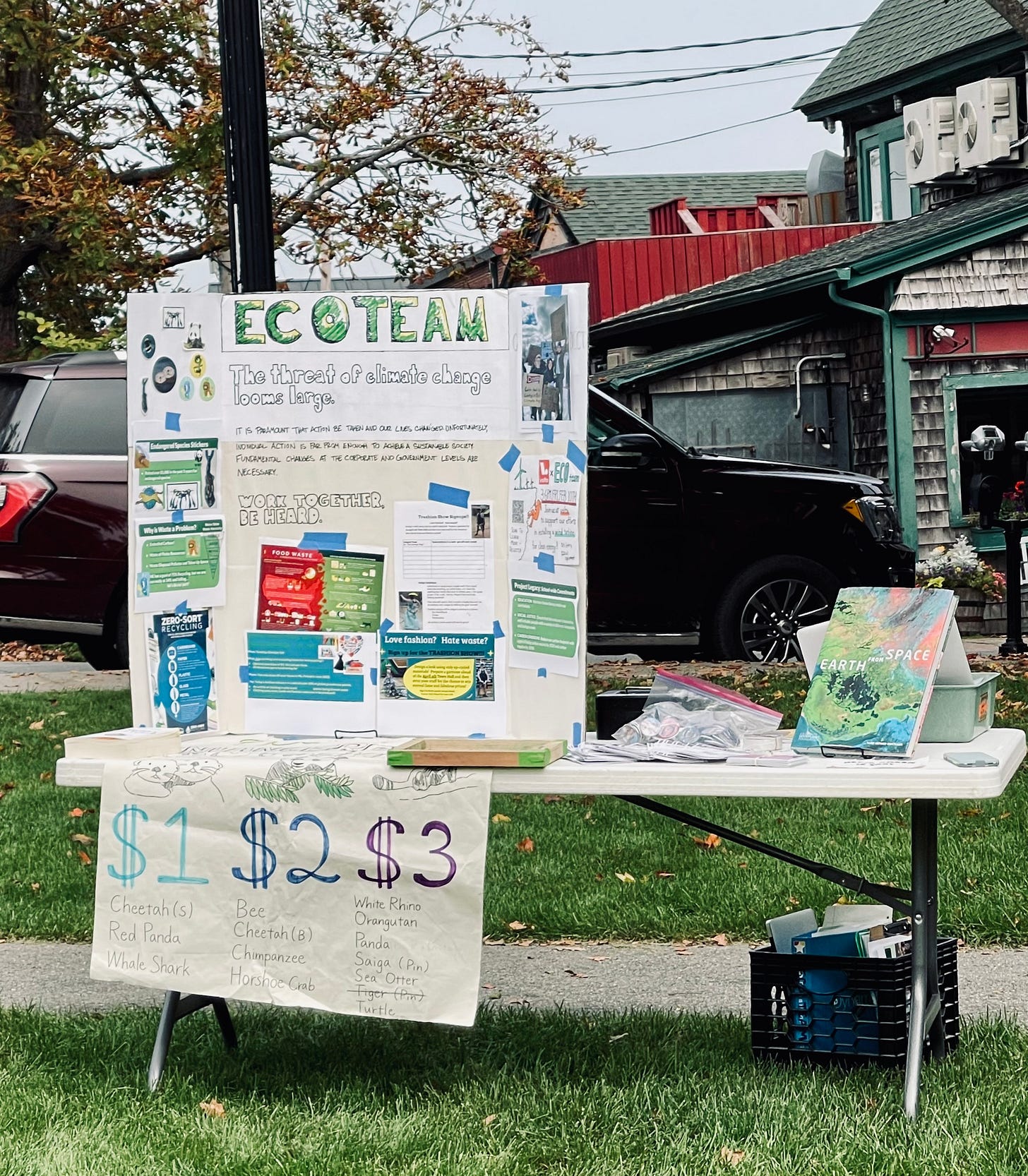BAR HARBOR—Kathleen Rybarz’ father worked for GM for his entire career, forty years, and her father made her promise she’d buy a GM someday, but she just couldn’t do it. The cars weren’t for her. She went with a Kia EV6, which uses the same platform as a Hyundai. It’s sporty and electric.
Rybarz stood in the parking lot by the Bar Harbor Congregational Church with her car’s hood and trunk wide open.
Her car, a sleek, blue baby wasn’t boxy like most of the other cars in the parking lot. It was, actually, kind of sexy.
“I love it,” the Lamoine selectman said as she moved to the back to illustrate how she charges the car at her daughter’s house when she drives to Portland, Maine from Lamoine to visit. She gets there, usually, with about 18% to 20% of a charge left. It depends on how fast she drives. When she hurried down because her daughter was in labor, it was a bit less because she was driving faster.
She stopped for a tiny recharge and started again. She made it on time. For longer routes, she has to plan where to charge and starts looking when she gets down to 50 miles or so. When her car says she has 0% charge, she can still drive it 4 miles “on empty.”
“It’s been great,” she said, “absolutely great.”
Her enthusiasm about switching to electric is contagious and she wasn’t alone Saturday as people perused the electric cars and talked to owners. There was a school bus, Town of Bar Harbor cars, and personal vehicles lined up in the parking spots, all part of a Climate to Thrive’s Climate Change Expo that was held there, the Village Green, and at the Jesup Memorial Library.
The September 30 event had workshops, food, music, that EV expo, as well as a community visioning workshop. The positive nature of individuals and community members coming together on multiple levels (personal choices, community and regional levels) was part of the emphasis at multiple tables, workshops and discussions.
WHAT IS NET ZERO EMISSIONS
Bar Harbor has pledged to become a net-zero carbon emissions. Having an EV fleet of municipal cars, potential solar panels on schools and other projects, lowering food waste, all lean into that.
Net zero emissions is explained by the World Economic Forum as:
“Global greenhouse gas emissions from human activity are in balance with emissions reductions. At net zero, carbon dioxide emissions are still generated, but an equal amount of carbon dioxide is removed from the atmosphere as is released into it, resulting in zero increase in net emissions.”
That’s often called decarbonizing, Terrapass explains it this way,
“It can refer to moving away from energy systems that produce carbon dioxide (CO2) and other greenhouse gas emissions, or it can refer to removing carbon buildup and carbon deposits from internal combustion engines. While both of these processes involve removing carbon, they do it in very different ways.”
The hope is that decarbonization will slow the warming climate.
LOCAL EV NEWS
Downeast Transportation’s Island Explorer bus system tested an electric bus last week, part of a U.S. Department of Transportation Pilot project.
Bar Harbor’s Climate Change Task Force has picked level-two EV chargers in town. Each charger costs just above $1,500, not including a software subscription, which will be an additional yearly $250 fee. The chargers will be placed at the lot behind Kid’s Corner, which is owned by the town and at the Park Street lot in between the town’s athletic fields. The cost for both installations will be about $16,000. The grant for the work was just over $20,000. The Town Council would have to approve the expenditure.
Last November, the task force members discussed where to place the chargers, which are part of a larger three-town grant that includes Mount Desert and Tremont. The towns decided that approximately $66,000 of the grant would be used on EV chargers. The remainder of the $91,700 grant was marked for a climate ambassadors program, climate plan outreach, decarbonization efforts, and EV outreach.
Earlier in 2022, the task force expressed that they wanted those chargers to be particularly accessible to year-round residents and residents who might be renting and don’t have the ability (financial or legal) to have chargers at their residences.
Original options had included the MDI YMCA parking lot and the Public Safety Building’s exterior lot. The grant did not restrict them to town owned property.
According to its bylaws, the task force was formed in 2020 and is meant “to define and recommend climate goals with the objective of drawing down carbon from the atmosphere and reducing community-wide greenhouse gas emissions by December 31, 2030.” Governor Janet Mills pledged three years ago that by 2045, Maine will be carbon-neutral. Being carbon-neutral basically means that you put out the same amount of carbon as you offset.
The hope is that by becoming carbon-neutral, people, communities, and businesses can help decrease greenhouse gasses. As MIT’s Climate Portal explains, “Greenhouse gases are gases—like carbon dioxide (CO2), methane, and nitrous oxide—that keep the Earth warmer than it would be without them.”
A CLIMATE TO THRIVE
The event was organized by A Climate to Thrive, a grass-root-originated nonprofit that is meant to help Mount Desert Island stay away from fossil fuels.
It’s current activities include:
Building Solutions including efficiency & electrification
Support for municipalities, businesses & organizations in climate action planning and implementation
Support for & collaboration with communities throughout Maine via Local Leads the Way
Community empowerment & engagement via the Climate Ambassadors Program and additional opportunities at the Community Climate Action Hub
Workshops on Saturday included community-driven energy solutions, climate change, and a visioning workshop for MDI. Climate activists from Mount Desert Island High School’s Eco-Team and College of the Atlantic’s Earth in Brackets attended. There were also tables about how food waste and climate change are connected. Members of Bar Harbor Climate’s Task Force were also there.
Food waste was an important topic at the expo as well.
According to the USDA,
“The U.S. Environmental Protection Agency (EPA) published a report in 2021 on the environmental impacts of food waste (PDF, 12 MB). EPA estimated that each year, U.S. food loss and waste embodies 170 million metric tons of carbon dioxide equivalent (million MTCO2e) GHG emissions (excluding landfill emissions) – equal to the annual CO2 emissions of 42 coal-fired power plants. This estimate does not include the significant methane emissions from food waste rotting in landfills.”
THE BIGGER CLIMATE IMPACT
Personal actions that are cognizant of greater impact are important and can feel empowering, but some attendees are unable to afford to get the loans to switch to EV or hybrid vehicles. Systemic changes on the municipal level like Bar Harbor’s also push toward carbon neutral status. Federal laws are also pushing for changes, but can be complicated.
According to a guest piece by Robinson Meyer for the New York Times,
“The I.R.A. introduced a pair of rebate programs meant to help working- and middle-class Americans afford to upgrade appliances and other features of their homes. These two programs, known as HOMES and HEEHRA, are important. When it’s finally put in place, HEEHRA will lower the cost of heat pumps and other climate-friendly appliances at the point of sale, making them more affordable to consumers, including those who are not even aware of the policy. More than perhaps any other programs in the law, these rebates are meant to allow low-income Americans to reduce their monthly energy costs. And because they involve direct cash grants, using the rebates will not require oweing any taxes to the federal government. That is huge for retirees and Social Security recipients, many of whom have no earned income and little to no federal tax liability.”
The IRA he refers to is explained earlier in the article as the Inflation Reduction Act.
“The Inflation Reduction Act, is working.
“America is putting in more solar panels than ever before, with installations expected to be up 52 percent compared with last year. The law has helped lock in America’s transition to electric vehicles. Companies have announced more than $60 billion in E.V. manufacturing investments since the I.R.A. passed, and Hyundai is rushing to finish its new E.V. factory in Georgia because the law’s incentives are so good. Across the country, investment in all forms of clean-energy manufacturing has ramped up, with spending this spring five times the level of two years ago, according to a new tracker from M.I.T. and the Rhodium Group, a research firm….
“The I.R.A. contains nearly $9 billion in rebates meant to help people upgrade and decarbonize their homes — for example, install an induction stove, a heat pump or a new electrical or insulation system.”
The gap between want to impact the climate in a positive way and to take advantage of new programs and the how to do so (afford a new hybrid/EV car, waste less food, decarbonize a home) is part of what A Climate To Thrive hopes to help with for both individuals and municipalities.
Others like Meyer want that too and they speculate that it shouldn’t be quite so hard.
LINKS TO LEARN MORE
https://www.aclimatetothrive.org/
Stats and Locations for Chargers
CNET story about infrastructure bill
FDA tips about reducing food waste.
Photos by Carrie Jones and Shaun Farrar
Correction and update: we made changes to the first paragraph and references to a back-up battery!
Also, Steamboat Landing and some other local sites have EV chargers that might not be on the links above. They are not inclusive!







